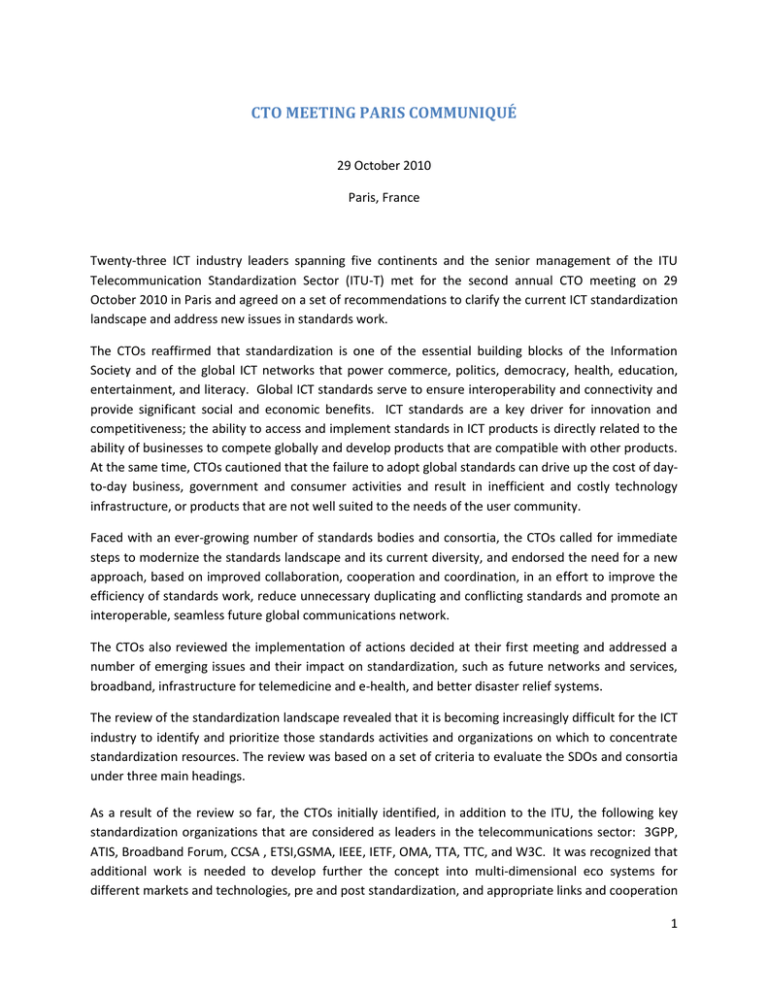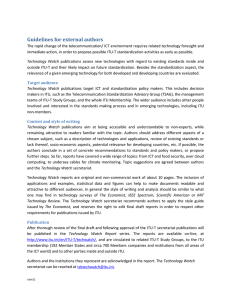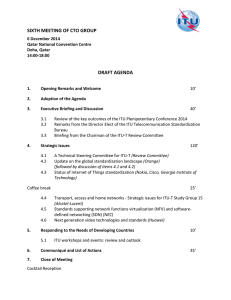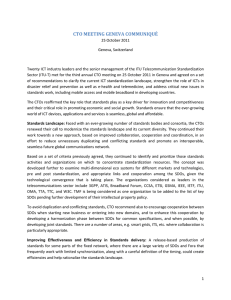CTO MEETING PARIS COMMUNIQUÉ
advertisement

CTO MEETING PARIS COMMUNIQUÉ 29 October 2010 Paris, France Twenty-three ICT industry leaders spanning five continents and the senior management of the ITU Telecommunication Standardization Sector (ITU-T) met for the second annual CTO meeting on 29 October 2010 in Paris and agreed on a set of recommendations to clarify the current ICT standardization landscape and address new issues in standards work. The CTOs reaffirmed that standardization is one of the essential building blocks of the Information Society and of the global ICT networks that power commerce, politics, democracy, health, education, entertainment, and literacy. Global ICT standards serve to ensure interoperability and connectivity and provide significant social and economic benefits. ICT standards are a key driver for innovation and competitiveness; the ability to access and implement standards in ICT products is directly related to the ability of businesses to compete globally and develop products that are compatible with other products. At the same time, CTOs cautioned that the failure to adopt global standards can drive up the cost of dayto-day business, government and consumer activities and result in inefficient and costly technology infrastructure, or products that are not well suited to the needs of the user community. Faced with an ever-growing number of standards bodies and consortia, the CTOs called for immediate steps to modernize the standards landscape and its current diversity, and endorsed the need for a new approach, based on improved collaboration, cooperation and coordination, in an effort to improve the efficiency of standards work, reduce unnecessary duplicating and conflicting standards and promote an interoperable, seamless future global communications network. The CTOs also reviewed the implementation of actions decided at their first meeting and addressed a number of emerging issues and their impact on standardization, such as future networks and services, broadband, infrastructure for telemedicine and e-health, and better disaster relief systems. The review of the standardization landscape revealed that it is becoming increasingly difficult for the ICT industry to identify and prioritize those standards activities and organizations on which to concentrate standardization resources. The review was based on a set of criteria to evaluate the SDOs and consortia under three main headings. As a result of the review so far, the CTOs initially identified, in addition to the ITU, the following key standardization organizations that are considered as leaders in the telecommunications sector: 3GPP, ATIS, Broadband Forum, CCSA , ETSI,GSMA, IEEE, IETF, OMA, TTA, TTC, and W3C. It was recognized that additional work is needed to develop further the concept into multi-dimensional eco systems for different markets and technologies, pre and post standardization, and appropriate links and cooperation 1 among the SDOs, given the technological convergence that is taking place. This would help avoid duplicate and conflicting standards and foster their faster and more efficient development, benefitting industry and consumers. A recent example is the strong support of many operators and manufacturers for the use of the IMS platform for Voice over LTE, driven by GSMA. The CTOS recognized that the challenge will be to create the appropriate vehicle for collaboration to take place that is both efficient and effective. They acknowledged the need for efficient and continuous dialogue and collaboration between the key actors in ICT and telecom standardization, bilaterally as well as through established groups. This is particularly crucial when laying the foundations of the networks of the future. CTOs urged ITU-T to take a leading role to collaborate, coordinate and cooperate with other SDOs in developing standards for future networks and to assist developing countries in their planning and implementation. With respect to evolving infrastructure, CTO stressed that for each network segment (i.e. home, access, metro, backbone), a few technological options could be adopted, but the consistency among specifications has to be ensured. Moreover, any gaps in specifications have to be identified and filled. The opportunity for convergence of fixed and mobile services and the trend towards the use of common architectures within the fixed and mobile networks will be facilitated by a reduction in duplicative and competing specifications, as an example interconnection models for voice between operators are technically evolving to IMS. When necessary, a harmonization phase should be instigated, as appropriate, to drive for common specifications and maximize the potential economies of scale. In addition, the adoption of “specification releases” was recommended not only for the mobile network (as already developed by the 3GPP), but also for the fixed and the convergent infrastructure, by establishing an effective process of collaboration between all the relevant SDOs. Such a process to produce specification releases in the fixed networks needs to be well structured with the support of a worldwide recognized SDO. The ITU-T should take the lead to work with other SDOs to define such a process. At the opening of the meeting, Mr. Jean-Philippe Vanot, Deputy CEO Orange FT Group, welcomed the progress made by the ITU and UNESCO-led Broadband Commission for Digital Development, which is promoting the adoption of broadband-friendly practices and policies to enable the entire world to take advantage of the benefits offered by broadband. The CTOs recognized that broadband infrastructure should be based on voluntary, consensus-based technical standards developed by the private sector through global organizations such as ITU and the Broadband Forum. Developing business models for affordable and sustainable broadband systems in developing countries is also a priority of service providers in these countries. An essential item on the agenda was the discussion of the role of ICT in disaster relief. Natural disasters, such as the earthquake in Haiti or the flooding in Pakistan, require immediate joint action from the local authorities and the international community. CTOs stressed the importance of robust and reliable telecommunications infrastructure, wired or wireless, and urged the TSB to encourage the ITU to continue its work in promoting the development and use of early warning and disaster relief applications and services. 2 Broadband deployment is also vital to the growth of telemedicine and e-Health. Considering the rapid growth of aging populations worldwide, ICT-enabled healthcare will become increasingly indispensable and its use widespread. CTOs recommended that ITU accelerate its activities in developing the necessary infrastructure standards and cooperate with other organizations to foster reliable, secure and interoperable e-health solutions. They called on ITU to continue to take a leading role in the United Nations Digital Healthcare Initiative. Data traffic over communications networks is growing exponentially driven by applications such as ehealth, but also by new network architectures such as sensor networks. When devices, instrumentation and data sources/repositories are networking without a person in any of the communication paths, they are commonly referred to as the ’Internet of Things’ (IoT). While today’s IoT applications are mainly for business, the consumer market is steadily growing. As a result, networks could play an important role in a competitive data brokerage marketplace, taking into account privacy concerns. The CTOs called for work on standards to address concerns related to privacy, security, identity management and ease of deployment. At the same time, a need exists for standards that reflect a human dimension of emerging technologies, based on user-friendly design and planning, while ensuring that ICTs are available and accessible to all. The CTOs stressed the critical need for the development of standards to facilitate the uptake of intelligent transport systems (ITS), which are needed for energy efficiency as well as for safety reasons. Key points for future work include standards that will help reduce driver distraction and improve roaduser behavior, as well as the need to study new standardized wireless access technologies, including the possibility of applying TD-LTE, for vehicle-to-vehicle and vehicle-to-infrastructure cooperative systems. Through the development of new standards, greater emphasis needs to be given to the potential for ITS to both increase the capacity of the existing transport networks as well as encourage the buildout of new networks. The CTOs also recognized the increasing role of developing countries in standards use and development, in light of the rapid growth of ICTs in those countries. They renewed their call for increased efforts to Bridge the Standardization Gap and pledged to foster public-private partnerships to improve capacity building and frameworks in developing countries as a vital step in enhancing their standards readiness and the participation of companies from those countries in standards development. The ITU-T Voluntary Fund on Bridging the Standardization Gap and related activities were seen as a means to offer training and to help developing countries obtain the necessary capability to participate effectively in global and regional standards bodies. Three of the participating companies already contribute to this fund. Interoperability, competition, innovation, and infrastructure development that addresses user needs on a timely and cost effective basis are important to all countries, including developing countries. A number of CTOs expressed concerns about the ITU Conformance Assessment and Interoperability Program, especially with respect to the proposed future ITU Mark and the ITU Conformance Assessment Database, in that these activities would neither guarantee interoperability nor help resolve the counterfeit equipment problem in developing countries. Their concerns were that a mark and/or database could confuse users, increase costs, delay deployment of infrastructure and the applications 3 that they support, as well as inhibit innovation. Based on the recent ITU Plenipotentiary Resolution, these CTOs made specific recommendations related to future interoperability events and proposed that the ITU role in any regional testing centers be toward human capacity building. Their suggestion is to focus the Program on developing country needs via interoperability events, such as those recently conducted in Geneva and Singapore, which will help to improve the quality of ITU-T Recommendations, and ITU human capacity building programs to assist developing countries in regional testing centers being funded by other UN entities. The CTOs expressed their appreciation for the progress that had been made under the Action Plan adopted at their first meeting. In particular they recognized that concrete actions are needed to improve coordination and collaboration with other ICT actors to bridge the IT and telecom cultures. The efforts of ITU and the ICT community to tackle climate change were encouraged, notably the work of ITU-T Study Group 5 to develop standards for universal mobile phone chargers and to measure the positive impact of ICTs on measuring, mitigating and adapting to the effects of climate change. They welcomed the establishment of the ITU-T Focus Groups on Smart Grids and Cloud Computing, as they can play an important role in addressing the standards needs of these emerging products and services. Other specific recommendations addressed to the TSB Director include: 1. Consider the possibility to organize an event on home networking services, the scope and objectives could include service requirements and migration; QoS; security aspects; interfaces and interoperability; control and management; and new features (e.g. ICTs and Climate Change). The results from such workshops should be examined and a status report and/or issue list prepared for consideration as part of the ITU-T home networking effort. 2. Develop a model for affordable and sustainable (wireless) broadband in developing countries, in addition to providing technological assistance, working in conjunction with governments, NGOs and private sector, and hold a workshop or meeting on this topic. 3. To encourage the next generation of standards makers, continue Kaleidoscope events and collaborate with academia and other SDOs and the private sector to develop and establish standards education programs. The meeting took place at the headquarters of France Telecom/Orange in Paris, France. The genesis for the CTO meeting came from the very successful Global Standards Symposium in October 2008, which led the World Telecommunication Standardization Assembly (WTSA-08, Johannesburg) to adopt Resolution 68 that requires ITU-T to strengthen its efforts to respond to the needs of high-level industry executives in terms of their identified requirements and priorities for standardization, in order to strengthening the role of ITU-T, taking account of the needs of developing countries. The first-ever CTO meeting was held at ITU in Geneva, Switzerland on 6 October 2009. At the invitation of Mr. Malcolm Johnson, Director of the ITU Telecommunication Standardization Bureau, CTOs and equivalents 4 of 23 leading companies of the ICT industry, representing major telecom operators and manufacturers, and software vendors, attended the Paris meeting.i The participants welcomed the frank and positive discussions, agreed on a set of actions to be taken and decided to continue to meet regularly. ITU will host the next meeting in October 2011 in Geneva to coincide with the TELECOM WORLD event. i The participating organizations were: Alcatel-Lucent, China Unicom, Cisco, Ericsson, Freescale, Fujitsu, Huawei, KDDI, KT Corp, Microsoft, NEC, Nokia Siemens Networks, NTT, Orange FT Group, Psytechnics, RIM, Telecom Italia, Telefonica, Telkom South Africa, Telstra, Ukrtelecom, Verizon, and ZTE. (Vodafone associated to the meeting.) 5



